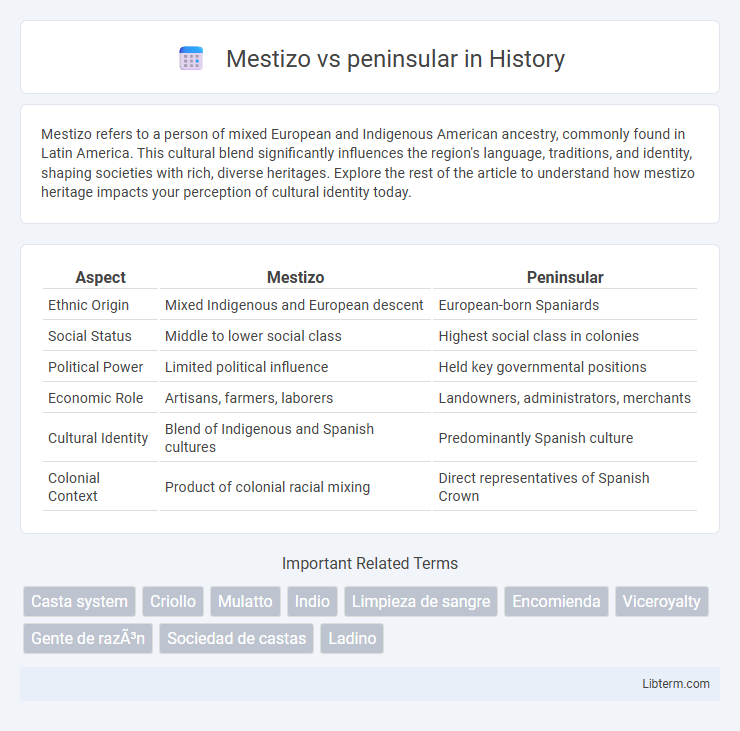Mestizo refers to a person of mixed European and Indigenous American ancestry, commonly found in Latin America. This cultural blend significantly influences the region's language, traditions, and identity, shaping societies with rich, diverse heritages. Explore the rest of the article to understand how mestizo heritage impacts your perception of cultural identity today.
Table of Comparison
| Aspect | Mestizo | Peninsular |
|---|---|---|
| Ethnic Origin | Mixed Indigenous and European descent | European-born Spaniards |
| Social Status | Middle to lower social class | Highest social class in colonies |
| Political Power | Limited political influence | Held key governmental positions |
| Economic Role | Artisans, farmers, laborers | Landowners, administrators, merchants |
| Cultural Identity | Blend of Indigenous and Spanish cultures | Predominantly Spanish culture |
| Colonial Context | Product of colonial racial mixing | Direct representatives of Spanish Crown |
Introduction to Mestizo and Peninsular Identities
Mestizo identity emerged from the cultural and genetic blending of Indigenous peoples and Spanish colonizers in Latin America, creating a diverse, hybrid social group distinct from both parent populations. Peninsular identity refers specifically to Spaniards born in the Iberian Peninsula who held privileged social, political, and economic status in colonial society, often serving as colonial administrators and elite landowners. These two identities symbolize the rooted colonial hierarchy where peninsulares asserted dominance over mestizos, shaping racial and social structures that influenced Latin American history.
Historical Background of Social Classes in Colonial Latin America
In Colonial Latin America, the social hierarchy was deeply influenced by racial and birthplace distinctions, where Peninsulares--Spaniards born in Spain--occupied the highest social and administrative positions, wielding significant political and economic power. Mestizos, individuals of mixed Indigenous and European ancestry, occupied an intermediate social status, often engaged in artisan trades, small-scale commerce, or agricultural work, reflecting limited upward mobility. This rigid caste system institutionalized ethnic divisions, reinforcing colonial dominance and shaping socio-economic dynamics that persisted for centuries.
Defining ‘Mestizo’: Origins and Cultural Significance
Mestizo refers to individuals of mixed European, primarily Spanish, and Indigenous American ancestry, emerging during the colonial period in Latin America. This identity embodies a complex blend of cultural, linguistic, and social elements from both Indigenous and Spanish heritages, shaping unique traditions and societal roles. The mestizo population became a distinct social category, often positioned between the peninsulares -- Spaniards born in Spain holding elite status -- and Indigenous peoples, influencing the colonial caste system and post-colonial national identities.
Who Were the Peninsulares? Status and Power
Peninsulares were individuals born in Spain who migrated to the Americas during the colonial period, holding the highest social status and political power in Spanish colonies. They dominated administrative positions, controlled key economic resources, and maintained exclusive privileges over local-born groups, including mestizos. Their authority was reinforced by the Spanish Crown, which prioritized peninsulares for governance and elite roles to uphold colonial order and loyalty.
Socio-Economic Differences: Mestizos vs Peninsulares
Mestizos, born from mixed indigenous and European ancestry, typically occupied lower socio-economic tiers compared to Peninsulares, who were European-born Spaniards holding elite administrative and economic positions in colonial society. Peninsulares controlled land, wealth, and governmental power, establishing rigid socio-economic hierarchies that limited Mestizos mainly to skilled labor, trades, and local commerce. This disparity reinforced systemic inequality, with Peninsulares enjoying privileged access to education, political influence, and economic resources unavailable to Mestizos.
Legal Rights and Privileges: Contrasts Between Groups
Peninsulares, born in Spain, held superior legal rights, often occupying high-ranking government and ecclesiastical positions within colonial societies. Mestizos, of mixed Indigenous and Spanish ancestry, faced legal restrictions limiting their access to political power and economic privileges. This hierarchical legal framework entrenched social inequality by granting peninsulares exclusive privileges like land ownership and legal protections that Mestizos were systematically denied.
Cultural Contributions and Legacy
Mestizos, born from Indigenous and Spanish ancestry, enriched Latin American culture by blending Indigenous traditions with European influences in language, cuisine, and art, creating a unique cultural identity. Peninsulares, Spanish-born elites, introduced European administrative systems, Catholicism, and classical art forms, shaping colonial governance and cultural institutions. The legacy of Mestizos is seen in contemporary Latin American multiculturalism, while Peninsulares left enduring impacts on societal hierarchy and colonial architecture.
Role in Independence Movements
Mestizos played a crucial role in Latin American independence movements by mobilizing local populations and challenging colonial social hierarchies, leveraging their mixed indigenous and European heritage to rally diverse groups. Peninsulares, Spanish-born elites, often resisted these movements to maintain their political and economic dominance, frequently serving as loyal administrators or military leaders defending colonial rule. The conflict between Mestizos seeking equality and autonomy versus Peninsulares defending imperial interests significantly shaped the trajectory and outcomes of independence struggles across the continent.
Lasting Impact on Modern Latin American Societies
Mestizos, a blend of Indigenous and European ancestry, shaped the cultural and social fabric of modern Latin America by fostering diverse identities, languages, and traditions that underscore national pride and resistance to colonial legacies. Peninsulares, Spanish-born elites who held political and economic power during colonial times, contributed to hierarchical social structures and land distribution patterns still evident in contemporary Latin American inequality and governance challenges. The lasting impact of this dichotomy influences modern debates on race, class, and cultural heritage, driving movements toward inclusion and social justice across the region.
Conclusion: Relevance of the Mestizo and Peninsular Divide Today
The Mestizo and Peninsular divide remains relevant today as it highlights ongoing socio-cultural dynamics and identity negotiations within Latin American societies. Understanding this historical distinction enriches contemporary discussions on race, class, and heritage, influencing policies on social inclusion and cultural recognition. The enduring legacy of this divide continues to shape national identities and social stratification across the region.
Mestizo Infographic

 libterm.com
libterm.com